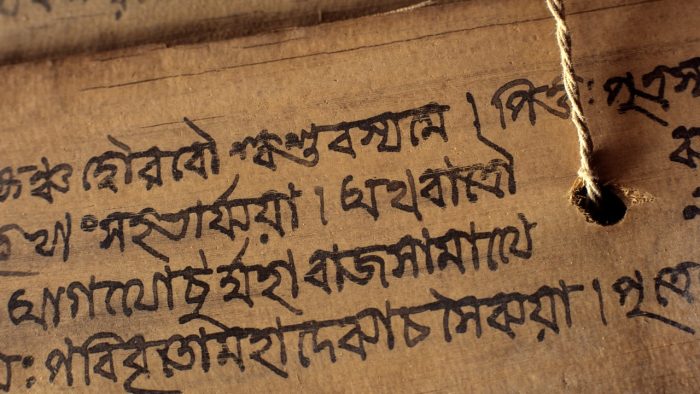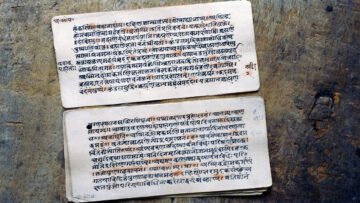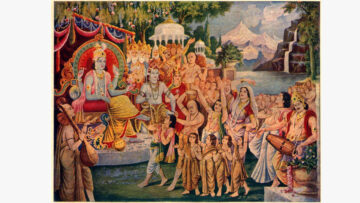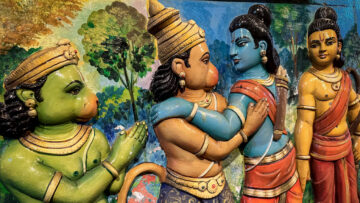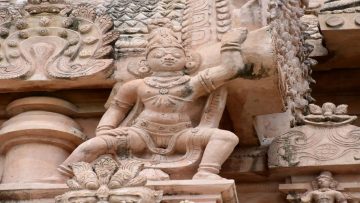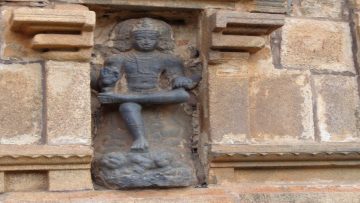Every Hindu comes across these statements in a lifetime:
‘Vedas are nothing but a tool to deceive the masses, designed by Brahmins.
and
‘Vedas are divine words. They are ‘Apaurusheya’ that is nobody authored them.’
But the reality is that a vast majority of people claiming to profess either of these thoughts are mired in certain prejudices. The former thought is an outcome of ideological rivalry and the latter is a belief of people owing to their adherence to a certain creed.
Therefore it is very important for an average Hindu to know the traditional view on the meaning of Apaurusheya. It must be told what the actual connotations of this word are.
In order to understand a belief system, it is very important to understand:
- Its notion of the ultimate goal.
- Its take about the world and
- Its view of beings.
- The Buddhists are vijñānavadis. (विज्ञानवादी) They opine world nothing but individual’s perception). ‘Shoonya’ (vacuum) is the only reality that is to be known.
- The Jains believe the world is made up of Pudgalas (one of the material causes of world in Jainism). Individuals escape the cycle of birth and rebirth via penance and practice. They do not believe in a god who creates this arrangement.
- Abrahamic faiths like Christianity and Islam accept that God created the world. God is an extra-cosmic entity. On the last Day of Judgment, beings go to hell and heaven.
Now let us see what the Vedas have to say about the ultimate, ordinary beings and the world. A set of questions and their answers in the Kenopanishad’s inception mantras will shed some light on the supreme of the Vedas.
केनेषितं पतति प्रेषितं मनः केन प्राणः प्रथमः प्रैति युक्तः ।
केनेषितां वाचमिमां वदन्ति चक्षुः श्रोत्रं क उ देवो युनक्ति ।।
(Willed by whom does the directed mind go towards its object? Being directed by whom does the vital force that precedes all, proceed (towards its duty)? By whom is this speech willed that people utter? Who is the effulgent being who directs the eyes and the ears?)
श्रोत्रस्य श्रोत्रं मनसो मनो यद्वाचो ह वाच्ँस उ प्राणस्य प्राणः।
चक्षुषश्चक्षुरतिमुच्य धीराः प्रेत्यास्माल्लोकादमृता भवन्ति ।।
(It is the ear of the ear, the mind of the mind, tongue of the tongue (the speech of speech), and also the life of the life and eye of the eye. Having abandoned (the sense of self or I-ness in these) and arising above sense-life, the wise become immortal.)
न तत्र चक्षुर्गच्छति न वाग्गच्छति नो मनो न विद्मो न विजानीमो यथैतदनुशिष्यात् ।।
(The eye does not go there, no speech, nor the mind. We do not, therefore, know how to instruct one about it)
अन्यदेव तद्विदितादथो अविदितादधि।
इति शुश्रुम पूर्वेषां ये नस्तद्व्याचचक्षिरे ।।
(It is different from what is known and it is beyond what is unknown. Thus we have heard from the ancient preceptors who taught us that.)
यद्वाचाऽनभ्युदितं येन वागभ्युद्यते ।
तदेव ब्रह्म त्वं विद्धि नेदं यदिदमुपासते।
(What speech does not enlighten, but what enlightens speech, know that alone as Brahm, and not this which people worship here)
यन्मनसा न मनुते येनाहुर्मनो मतम् ।
तदेव ब्रह्म त्वं विद्धि नेदं यदिदमुपासते ।
(What one cannot think with the mind, but by which they say that the mind is made to think, know that alone as Brahm, and not this which people here worship.)
So here certain questions have been raised as to what is it, driven by which mind and the body are acting the way they act. What is it which is neither the senses nor the sensory potentials, but by which these two are able to carry out their functions?
This cause has been addressed as ‘Brahm’ (ब्रह्म). Contemplation on this ‘Brahm’ will pave our way to the true meaning of the aforesaid ‘Apaurusheya’. In the language of the Vedas ‘Brahm’ is our own self -आत्मा (Aatma). And everything we perceive is in fact ‘Brahm’ only-सर्वं ह्येतद् ब्रह्मायमात्मा ब्रह्म –Mandukya Upanishad-2.
Vedic seers proposed that nobody has seen the time when creation began. And nobody can look into in the future. Various takes regarding the origin and the dissolution are mere assumptions. The present, the past, the future have no meaning unless ‘I’ exist. The directions and sub directions begin with ‘me’. The vivid displays of nature are nowhere without me.
For example, you see a leaf. The leaf is seen by the ‘netrendriya’ (eyes). The ‘netrakara vritti’ (inclination formed by the vision) is there in the mind. The substratum and illuminator of this vritti is where the leaf is created. Thus without which the leaf cannot be established, is the cause of the leaf. It is the Jñāna (ज्ञान) which established the object.
The self is pure intelligence which establishes things via the senses, the mind, and the intellect. So we can say Jñāna is the instrument that leads to the world. Without the trio of the knower (ज्ञाता), known (ज्ञेय ) and Jñāna (ज्ञान) there is no world. As already mentioned the diverse objects that are perceived as separate from the knower are established by the Jñāna.
It means the object as it is known, is not outside. It is Jñāna which is pervading the object. And vritti arising due to Jñāna creates the object as it is known. Therefore it is fitting that Jñāna is also the material cause (upaadaana karna) of creation. The Jñāna imbued with samskara (mental inclinations) is Manas (मन).
Jñāna with dormant samskaras is Chitta (चित्त). Intellect (बुद्धि) is Jñāna unaffected with samskaras. Ahamnkara (अहंकार) is Jñāna which causes a false sense of individuality. The ultimate प्रमाण (proof) in establishing all these is Jñāna itself. Jñāna which devoid of the distinction of knower and the known is Aatma (आत्मा) or self, in which all the aforesaid dualities of knower and known are superimposed:
वदंति तत्वविदस्तत्वं यज्ज्ञानमद्वयम्।
ब्रह्मेति परमात्मेति भगवानीती शब्द्यते।।
Shrimad Bhagavatam- 1.2.11
(Knowers of reality address the non-dual Jñāna as tattva (essence). The same has been called brahm, bhagvana, paramatma.)
Regarding the Jñāna Swaroopa Atma, Shri Krishna says in the Bhagvad Gita 2.17 –
अविनाशि तु तद्विद्धि येन सर्वमिदं ततम्।
विनाशमव्ययास्य न कश्चित् कर्तुमर्हति।।
(Know that to be indestructible by which all this (creation) is pervaded, no one can cause the destruction of that imperishable)
Which is why Shruti too says in the Kathopanishad –
जायते म्रियते वा विपश्चिन्नायं कुतश्चिन्न बभूव कश्चित्।
अजो नित्यः शाश्वतोऽयं पुराणो न हन्यते हन्यमाने शरीरे ।।
Kathopanishad- 1.2.18
(The intelligent Aatma is not born, nor does it die, it did not spring from anything, and nothing sprang from it. It is unborn, eternal, everlasting, and ancient. It is not slain although the body is slain.)
That which superimposes its own qualities on something else owing to its proximity with that something else is called ‘Upadhi‘ (उपाधि- उप समीपे स्थित्वा आधिम्). The thing which is superimposed is Upadhi, and upon which it is superimposed is Upahita (उपहित). Upadhi does not penetrate upahita. An analogy of space in a pot and monastery is given to explain it.
Just as space in a pot (घटाकाश) is the same as the space outside the pot (महाकाश), yet there is a distinction between the two because the pot is Upadhi and space is Upahita. The same is applicable to the space in a monastery (मठाकाश).
These seemingly distinct spaces are due to Upadhis of Ghata and Matha. From the vantage point of space, there is no distinction. It is space only which is pervading in its uupadhis, yet it is separate from them.
Similarly, Manas, buddhi, Chitta, Ahamnkara, Jñānaendriya ज्ञानेन्द्रीय), Karmendriya (कर्मेन्द्रीय), Tanamatras (तन्मात्रा-sensory potentials) are upadhis for Jñāna Swaroopa Aatma ( ज्ञान स्वरूप आत्मा). And only due to these upadhis the world is perceived the way we know it. This superimposition is the cause of all interactions. All interaction is due to Vishaya (विषय- object) and Vishayee (विषयी-one who is aware of Vishays). Vishayas are many, Vishayee is one.
Vishayas are insentient and Vishayee is sentient. Unless Aatma identifies itself as senses, it cannot become the doer (कर्ता). Unless it identifies with the aforesaid four-fold mind comprising of Manas, Buddhi, etc, it cannot become Bhokta (भोक्ता- one who experiences the world).
The real nature of Atma is conscious, which is neither karta nor bhokta but द्रष्टा (one who sees or knows).
साक्षी चेता केवलो निर्गुणश्च।
Shvetashvatara Upanishad- 6.11.
Jñāna Swaroopa Aatma is the illuminator of all the upadhis and it is still separate from all of them. Without Atma, they have no independent existence of their own. Jñāna is its own proof. It is not proved by anything else. For concluding anything, Jñāna is the ultimate tool.
The Parramatta (प्रमाता-one who proves), the Pramaana ( प्रमाण- the proof), and Prameya (प्रमेय-the proved) are also established only by Jñāna. Pramana does not establish Jñāna but Jñāna establishes Pramanas.
Now talking about time. If we consider that Jñāna arises and dies in the stream of time and is transient then we are resorting to the Buddhist belief of Shunyata. But the Vedic view is that time is not separate from Jñāna. If the time has divisions or parts, then its Jñāna which establishes them.
If there are no divisions in time, then there is no question of its various units, or past and the future. If we say there was a time when time did not exist, then the time in which we imagine the absence of time, will be in time, which will be established by Jñāna only.
Similarly, Jñāna is not divided by space. As it has been established that Jñāna and time are not separate, the space arising in such a time too will not be different from Jñāna. The absence of space will be imagined in space called Jñāna only. The same is applicable to the objects arising in such a space.
So the Prakashaka (प्रकाशक) of space (देश), time (काल), mental inclinations (वृत्तिs), and sense of individuality in a state of being awake, in dreams and in deep sleep is Jñāna Swaroopa Aatma-non-dual consciousness. The Chetana (consciousness) whose Upadhi is Man, Buddhi, Chitta, Aham, senses, Prana (vital force), the body is Jeeva (जीव).
Chetan whose Upadhi is Universe (ब्रह्माण्ड) is Ishwara (ईश्वर). The nature of both Jeeva and Ishwara is the same, that is Jñāna Swaroop. But the seeming difference is due to Upadhi. To explain this another analogy is given:
जलाशये महाकाशस्तदवच्छिन्न एव हि। प्रतिबिम्बाख्यमपरं दृश्यते त्रिविधं नभः।।
बुद्धयवच्छिन्नचैतन्यमेकं पूर्णमथापरम्। आभासस्त्वपरं बिम्बभूतमेवं त्रिधा चितिः-
(Just as space in pond and space others are the same in nature, yet they are considered different. Similarly, the consciousness with the body and outside the body is of the same nature. And just as a reflection of space is seen on the surface of the pond, a reflection of consciousness in अंतःकरण or fourfold mind is चिदाभास (sense of individuality ) – Adhyatma Ramayana 1.45…
What is Prana (प्राण) for Jeeva, is Sutratma (सूत्रात्मा) for Ishwara. Similarly, Digdevta (दिग्देवता), Vaayu (वायु), Surya (सूर्य), Varuna (वरुण), Bhudevi (भू देवी), Agni (अग्नि), Indra (इन्द्र), Vishnu (विष्णु), Prajapati (प्रजापति) and Mitra (मित्र), are faculties for sound, touch, vision, taste, smell, speech, action, motion, procreation and excretion respectively. (Suta Samhita-4.4.23-24)

Similarly, Chandra (चन्द्र) is Manas. Brahma (ब्रह्मा) is Buddhi, Rudra (रुद्र) is Ahamnkara, Vasudev (वासुदेव) is Chitta. (Bhagwata– 3.6.23-26). A similar mention appears in Suta Samhita-4.4.26-27, with Chitta as Shiva (शिव).
At the level of Jeeva, Shruti says-
इन्द्रियेभ्यः परा ह्यर्था अर्थेभ्यश्च परं मनः। मनस्तु परा बुद्धिर्बुद्धेरात्मा महान्परः।
Kathopanishad- 1.3.10
(Beyond the senses, are the rudiments of its objects, beyond these rudiments is Manas, beyond Manas is Buddhi, and beyond the Buddhi is Aatma.)
At the level of Ishwar, things are like this –
भयादस्याग्निस्तपति भयात्तपति सूर्यः। भयादिन्द्रश्च वायुश्च मृत्युर्धावति पञ्चमः।।
Kathopanishad 2.3.3
(From the fear of it (ब्रह्म), Agni burns, from fear, the Surya shines, from fear Indra, Vaayu, and death the fifth, speeds.)
A similar example is seen in the Kenopnishad where ब्रह्म assumes the form of Yaksha and shatters the egos of the Devtas.
The same ब्रह्म assumes the form of Vishnu, Shiva, Devi, Indra, etc. because it is Jñāna Swaroop-
अयं ब्रह्मा शिवो विष्णुरयमिन्द्रः प्रजापति।
अयं वायुर चाग्निरयं सर्वाश्च देवताः।
Suta Samhita- 2.10.36
(It (ब्रह्म) is Brahmā, it is Shiva, it is Vishnu, Indra, Prajapati. It is Vaayu, it is Agni and it is all the Devtas)
Therefore it is said-
ज्ञानस्वरूपं अखिलं जगदेतबुद्धयः। अर्थ स्वरूपं पश्यन्तो भ्राम्यन्ते मोहसम्पलवे।।
(All that exists is Jñāna, ignorance sees diversity due to its own attachments- Vishnu Purana- 1.4.40)
Knowing all this, we conclude that at the root of the entire Prapancha (प्रपंच) we have Jñāna, which can neither be created nor be destroyed. Not even Ishwara can destroy Jñāna. Sages raise a question that if Ishwara can create and destroy Jñāna, then it must be ignorant before creating Jñāna. If it had no Jñāna then how could it create anything. Being Jñāna Swaroop is lakashna (लक्षण) of ब्रह्म. Brahm is the root of sense of Individuality or Chidabhas. Jagrit (जागृत– awake state) is result of sense of individuality in gross body, senses and fourfold mind. Dream state is work of sense of individuality in sublte body (सूक्ष्म शरीर) comprising of senses and fourfold mind. This Chidabhas get dissolved in Sushupti (सुषुप्ति– deep sleep). As already said, this Chidabhas only leads to perception of individual intellect (Buddhi) and individual desires in non-dual reality. It gets merged in Praagya (प्राज्ञ) in deep sleep. This Praagya has been addressed as Ishwara or Turiya Brahm ( तुरीय ब्रह्म) by the Shruti- Mandukya Upanishad 5.
The mental activities of Jagrit and Swapna states, with objects and their perciever, are not there in Sushupti. There is neither Jñātā nor Jñeya. There is only awareness of absence of Prapancha. At the universal level, it is called Maha Pralaya( महाप्रलय)- the great dissolution.
There is only effortless Sukha (bliss) in this state. There is neither Jñātā nor Jñeya. There is only awareness of Sukha. At a universal level, it is called Maha Pralaya (महाप्रलय)- great dissolution.
It is Praagya in which these names and forms get dissolved at individual level. At universal level, Ishwara is place of immersion of all names and forms. Just as at waking up all inclinations, desires, etc. wake up with us, similarly at universal level all the forms and intellects rise again. Actually this entire creation with names and forms is work of Buddhi.
इति तन्मयमैवेतत् सर्वे स्थावरजंगमम्।प्रलीयते चोद्भवति तस्मान्निर्दिष्यते तथा।।
Mahabharat- Shanti Parva,194,18
(This entire creation rises with the rise of Buddhi and is dissolved with its dissolution. This creation is hence work of Buddhi).
The connection between object and what it is called also arises.
नामरूपे व्याकरवाणी- Chandogya Upanishad- 6.3.2
The link between Names and forms is formed by Buddhi (intellect) via words (शब्द). The Vedas, the physical world, things beyond this physical world are the outcome of Buddhi. As already said , the universal Buddhi is ब्रह्मा (Brahmā) or Hiranyagarbha (हिरण्यगर्भ). That is what Shruti itself says that ब्रह्म is the root of Hiranyagarbha (universal Buddhi) and it activates the Vedas for it.
यो ब्रह्माणं विदधाति पूर्वं यो वै वेदांश्च प्रणिहोति तस्मै।
Svetashvatra Upanishad- 6.18
This concept is explained in Puranas in form of stories. You can see Brahm giving Veda Jñāna to Brahmā (ब्रह्मा) at the onset of the kalpa. Somewhere Shiva is Brahm, somewhere Narayana is supreme.
At our level the Vedas reside in Manomaya Kosha (मनोमय कोश). As the Taitiriya Upanishad states, the Vedas reside in Manomaya Kosha.
तस्य यजुरेव शिरः।ऋग्दक्षिणः पक्षः। सामोत्तरः पक्षः।
आदेश आत्मा । अथर्वाङ्गिरसः पुच्छं प्रतिष्ठा ।
तदप्येष श्लोको भवति ॥
Taitriya Upanishad-2.3.1
(Yajurmantras constitute the head of Manomaya Purusha (पुरुष), Rig mantras are its right-wing, Sama mantras constitute its left-wing, the Brahmana portion is its trunk, Atharvaangrisa mantras are the tail.)
The Jñāna of being Jñānaendriyas, Manas and feeling of ‘I’ and ‘mine’ constitute manomaya kosh. There are 5 sheaths in which Atma seems to be hidden. Annamaya Kosha (अन्नमय कोश), Pranamaya kosha (प्राणमय कोश), Manomaya kosha (मनोमय कोश), Vijñānamaya Kosha (विज्ञानमय कोश) and Anandmaya Kosha. (आनंदमय कोश). They are not literal layers.
It is just name given to different manifestations of Jñāna due to Upadhis. The gross body (स्थूल शरीर ) is Annamaya.The vital force of life (प्राण) imbued in senses of action constitutes Pranamaya Kosha. Vijñānamaya Kosha is constituted by Budhhi imbued with Vrittis and Jñānaendriyas. The Anandmaya Kosha is known in Samadhi (समाधि), or Sushupti, that is in absence of Vrittis.
The Jñāna of a normal individual is such that he/she identifies himself/herself as Annamaya. Now let us understand what Veda being in Manomaya Kosha implies. There are 4 states of Shabda- शब्द (sound). The most subtle and sublime state is called परा (Para). Forget about common people, even great sages rarely get to know this form of Shabda.
A lower level than this is Pashyanti (पश्यन्ती). At this level Shabda becomes manifest. Then there is the Madhayama (मध्यमा) state of Shabda, which is less subtle. Then there is the Vaikhri (वैखरी) state. It is the state in which Shabda is known to a common individual. The languages we speak and know are the Vaikhri level manifestation of Shabda.
When Chitta is taken from Vaikhri to Madhyama,from Madhyama to Pashyanti and finally to the Para state, then Veda mantras are seen within. That is why ऋषिs (Rishis) are called Mantra Drashtas (मन्त्र द्रष्टा) – seers of Mantra, and not creators of Mantra. They do Sakshatakara (शाक्षातकार) or direct experience of mantras at higher level of Prana and Chitta.
The form of Veda that we know is the Vaikhri level manifestation. The Rigveda itself testifies all this-
चत्वारि वाक् परिमिता पदानि तानि विदुर्ब्राह्मणा ये मनीषिणः।
गुहा त्रीणि निहिता नेंगयन्ति तुरीयं वाचो मनुष्या वदन्ति।।
Rigveda-1.164.64
Veda means- Jñāna (ज्ञान), which is inherent in all knowledge- प्रतिवोधविदितम् मतम्– Kena Upanishad – 2.4।। A part of this Jñāna is Rig, Yajur, Sama and Atharva mantras. Which is why a story comes in Taitriya Aranayaka, wherein Bhardwaj observes ब्रह्मचर्य to see the end of Vedas. Indra appeared and granted him a handful of soil from three mountains, whose peaks could not be seen. He said that these mountains are Vedas, what I gave is sufficient for humans- अनंता वै वेदा। Which is why the Veda has been called the life breath of the Ishwahara.
अस्य महतो भूतस्य निश्वसितमेतद्यदृग्वेदो यजुर्वेदः सामवेदोऽथर्वांङ्गिरस।
Brihadaranyak Upanishad- 2.4.10
Therefore it does not matter at which point of time the Rishis saw mantras, when the Vedas were written in the Vaikhri manifestation. The Vaikhri manifestation of Vedas comes into existence via the vagendriya ( वागेन्द्रीय), sense for speech. Hence it is born in space and time and is destructible too.
ऋचो यजूंषि सामाजिक शरीराणि व्यपाश्रिताः। जिह्वाग्रेषु प्रवर्तन्ते यत्नसाध्या विनाशिनः।
Mahabharat, Shanti Parva, 205,16
(The Rik, yajush ana Sama mantras are dependent on body. They are manifested at the tongue, imbibed via practice and are ephemeral like other things born in space and time)
They stay ‘apaurusheya’ because no one can create Jñāna nor can anyone destroy it. Which is why Veda called Shabda Brahm. This sublime principle is not a hindrance to any scientific or historical proposition. Theories may come and go but the principle of Vaidikas remains unaffected. Hence Vyasa rightly says about ब्रह्म in his ब्रह्म सूत्र –
जन्माद्यस्य यतः– its non-dual substratum in which जन्मादि– origin, sustenance, dissolution happpen- 1.1.2
शास्त्रयोनित्वात– its womb of all Shastras.1.1.3
(Editor’s note: This article has been edited on August 31st 2020 as per author’s directions in some places for reader clarity)
Disclaimer: The opinions expressed in this article belong to the author. Indic Today is neither responsible nor liable for the accuracy, completeness, suitability, or validity of any information in the article.

